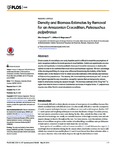Por favor, use este identificador para citar o enlazar este ítem:
http://www.alice.cnptia.embrapa.br/alice/handle/doc/1053100| Título: | Density and Biomass Estimates by Removal for an Amazonian Crocodilian, Paleosuchus palpebrosus. |
| Autor: | CAMPOS, Z.  MAGNUSSON, W.   |
| Afiliación: | ZILCA MARIA DA SILVA CAMPOS, CPAP; William E. Magnusson, Instituto Nacional de Pesquisas da Amazônia, Manaus, Amazonas. |
| Año: | 2016 |
| Referencia: | Plos One, v.11, n.5, May 2016. |
| Páginas: | p.1-7 |
| Descripción: | Direct counts of crocodilians are rarely feasible and it is difficult to meet the assumptions of mark-recapture methods for most species in most habitats. Catch-out experiments are also usually not logistically or morally justifiable because it would be necessary to destroy the habitat in order to be confident that most individuals had been captured. We took advantage of the draining and filling of a large area of flooded forest during the building of the Santo Antônio dam on the Madeira River to obtain accurate estimates of the density and biomass of Paleosuchus palpebrosus. The density, 28.4 non-hatchling individuals per km2, is one of the highest reported for any crocodilian, except for species that are temporarily concentrated in small areas during dry-season drought. The biomass estimate of 63.15 kg*km-2 is higher than that for most or even all mammalian carnivores in tropical forest. P. palpebrosus may be one of the World´s most abundant crocodilians. |
| Thesagro: | Crocodilo |
| NAL Thesaurus: | Paleosuchus palpebrosus Amazonia |
| Palabras clave: | Crocodilia |
| DOI: | http://dx.doi.org/10.1371/journal.pone.0156406 |
| Tipo de Material: | Artigo de periódico |
| Acceso: | openAccess |
| Aparece en las colecciones: | Artigo em periódico indexado (CPAP)  |
Ficheros en este ítem:
| Fichero | Descripción | Tamaño | Formato | |
|---|---|---|---|---|
| journal.pone.0156406.PDF | 816,47 kB | Adobe PDF |  Visualizar/Abrir |









